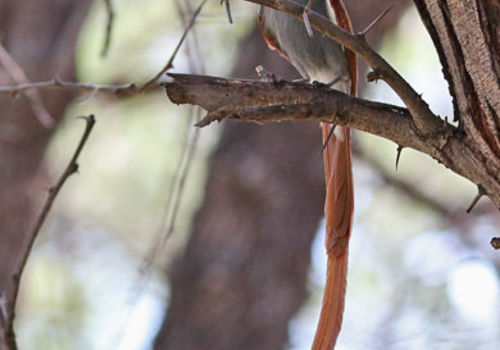
African paradise flycatcher
Terpsiphone viridisAfrican paradise flycatcher
Introduction: African paradise-flycatchers (Terpsiphone viridis) inhabit forest and woodland but are absent from arid savannah. Usually they are found singly or in pairs and are tolerant of human presence. Plunge-dives into water to bathe, being mindful to keep the long tail feathers out of the water. Dips bill in water in flight to drink. Aggressive towards many other animals and reptiles such as the fork-tailed drongo, mousebirds, Hadeda ibis, domestic dogs and cats and boomslang.
Distribution: Absent from southern Namibia and Namib Desert. Found in Epupa Falls, Etosha National Park and Zambezi Region (formerly the Caprivi Strip).
Diet: Looks upwards from perch to search for flying insects. Eats grasshoppers, butterflies, beetles, mosquitoes, caterpillars, cockroaches, spiders and small berries.
Description: Metallic greenish black head, throat and nape. Bright rusty coloured back, upper rump and tail. Viridis is Latin for 'green' which refers to their greenish-tinged head. Distinctive long tail feathers.
Breeding: A cup-shaped nest built of bark strips and bound with spider web is lined with grass, rimmed with pine needles. Females lay between 1 and 4 eggs between October and November and incubate for up to 19 days.
Size: 35cm.
Weight: 14g.
Klein Windhoek

